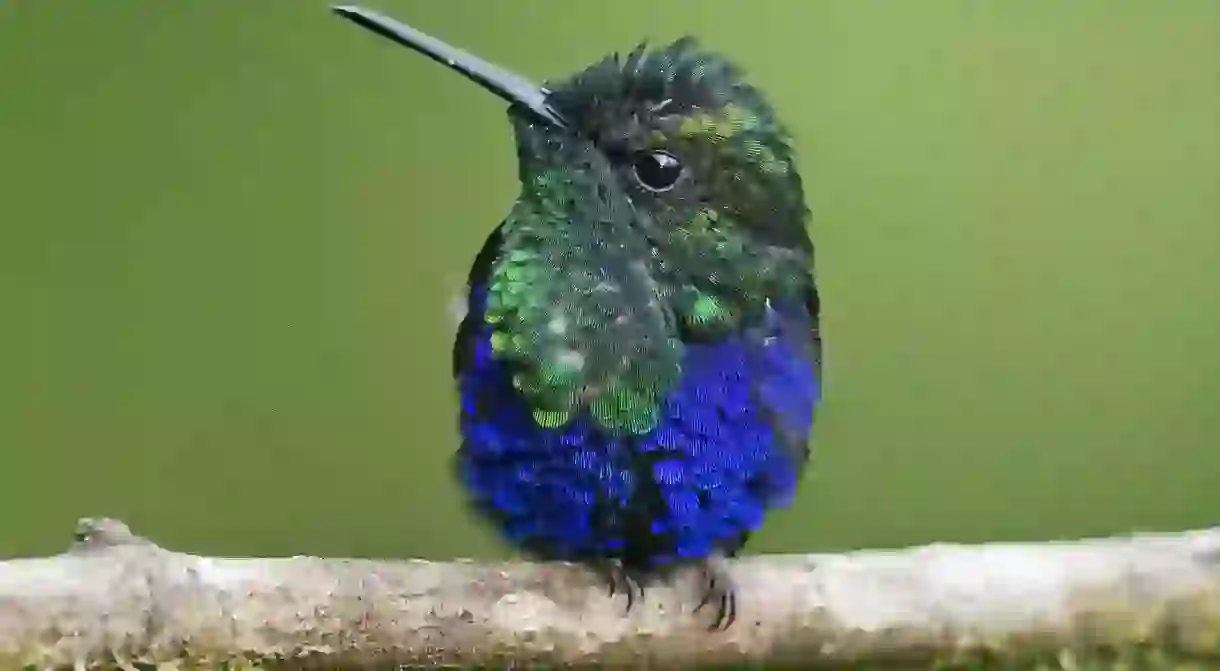A Guide to Ecuador's Different Hummingbirds

Ecuador is home to 152 species of hummingbirds and while it seems near impossible to see them all, how about trying to spot one from each family. Here are short descriptions of some iconic species that should be easy to find.
The Hermits
Hermit hummingbirds are fast, shy and have long curved beaks. While they are not brilliantly colored, they do have the most beautifully fanned tails when they stop mid-flight to check out a feeder or a hiker on the trail. The White-whiskered Hermit is almost guaranteed to visit feeders in Mindo and Milpe.

The Violetears
There are three species of Violetears in Ecuador. All three have a few deep purple feathers where an ear might be, which pop out from their heads when they are angry or making a display. The most brilliant is the Sparkling Violetear with its green body marked with a bright blue chest and a stripe of dark blue and purple across its cheek. The Green Violetear lacks the blue colors on the chest. The dull cousin is the Brown Violetear, looking very plain in brown except for the dusting of purple feathers on its cheek and a brilliant turquoise green spot at the base of its throat.

The Sunangels
Sunangel hummingbirds tend to live in isolated pockets and can be harder to find. The Gorgeted Sunagel is found low on the West Slope and might be seen at some of the lodges in Milpe. The Amethyst-throated is found deep in the south, the nearby borders of Peru lodges in Zamora being its most likely location.

The Thorntails
These tiny birds stand out for their impressive little tails. All Thorntails are green with a white band on their backsides. Different species live on either side of the Andes. The Green Thorntail can be seen in Milpe and the Wire-crested in Wild Sumaco.

The Sylphs
The two species of Sylphs look almost identical with their neon blue and incredibly long tails but they live on opposite sides of the Andes. The West Slope version is the Violet-tailed Sylph and can be seen at feeders in the Tandayapa Valley. It is a notoriously difficult bird to photograph for its speed and shyness at the feeders. The Long-tailed Sylph can be seen on the East Slope from Guango Lodge down to Cosanga.

The Thornbills
Not all hummingbirds have long beaks. The Thornbills and their close cousins the Metaltails have very short, thin beaks, perfect for high altitude flowers. The Purple-backed Thornbill can be seen at the Yanacocha Reserve near the rocky mountain faces where it nests and the Blue-mantled Thornbill can be found on the hiking trails near the Papallacta Pass.

The Pufflegs
The Puffleg hummingbirds are just plain adorable with their cotton ball ankle coverings. The Yanacocha Reserve is home to the Sapphire-vented Puffleg, the Golden-breasted Puffleg and the rare Black-breasted Puffleg. The Booted-rackettail could also be called a Puffleg and it can be seen on the West Slope in Tandayapa and Mindo and on the East Slope in Cosanga, where it has tan colored cotton balls instead of white.

The Coronets
These funny hummingbirds are the clowns of any hummingbird garden. Coronets love to fight each other, they always land with wings up, hold them in place a brief second, then perch comfortably. If you’re after dynamic shots of active birds, then head to see the Chesnut-breasted Coronet in Tandayapa Valley, Mindo, and San Jose de Milpe, the Velvet-breasted at the Angel Paz Lodge, or the Chesnut-breasted at Guango Lodge, Cosanga, or Wildsumaco.

The Brilliants
The Brilliants have long, thick beaks, strong bodies and usually some kind of bright feathers at the base of their throats. The Empress Green and the Green Crowned are West Slope birds, the Violet-fronted and Black-throated live east of the Andes, while the Fawn-breasted can be found on both slopes.

The Woodstars
The Woodstar hummingbirds are some of the smallest in Ecuador. When Woodstars approach a feeder, they sound like giant bumblebees, buzzing their way to nectar. The females are rather plain but the males have brilliant hot pink or purple throats that shine even in the dim cloud forest light. Look for a variety of Woodstar at just about any hummingbird garden in Ecuador.

The Sapphires
The Sapphires all share a version of bright green, deep blue and copper brown coloring, just in slightly different variations. But the most colorful is the Golden-tailed Sapphire, found in the Amazon Basin and at the Wildsumaco Lodge.

The Woodnymphs
These small, round hummingbirds are super colorful, with brilliant green and blue iridescent feathers. The Crowned Woodnymph can be seen in the Milpe region west of the Andes and the Fork-tailed is found in the Amazon Basin east of the Andes.














